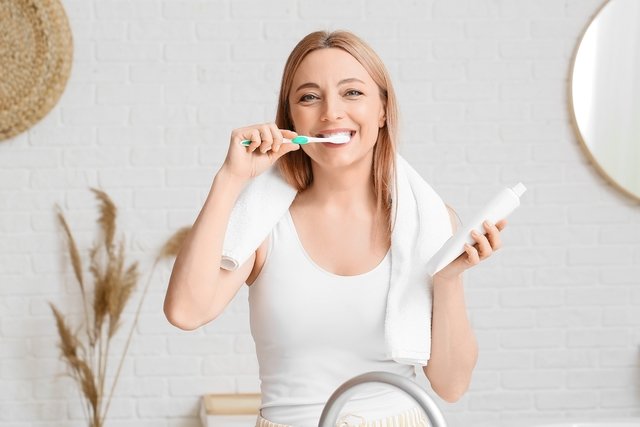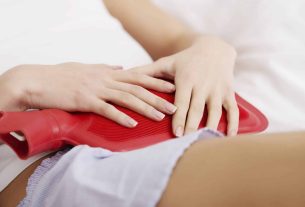To brush your teeth correctly, you must use a toothbrush, preferably with soft bristles, or an electric toothbrush, fluoride toothpaste, and floss before brushing your teeth, at least once a day.
It is recommended to brush your teeth at least twice a day, one of which should always be before bed, as bacteria are more likely to accumulate in the mouth at night.
Brushing your teeth correctly is essential to prevent the development of cavities and bacterial plaque, as well as other oral diseases, such as gingivitis or periodontitis, which can cause bad breath, pain and difficulty eating, for example.

How to brush your teeth correctly
To have good oral health, it is important to brush your teeth well daily by following these steps:
- Floss or tape your teeth before starting to brushto remove food accumulated between teeth and gums, and facilitate the removal of bacterial plaque;
- Putting toothpaste on your brush which can be manual or electric;
- Touch the brush bristles to the area between the gums and teeth, making circular or vertical movements, from the gums outward, and repeating the movement about 10 times, for every 2 teeth. This procedure must also be done on the inside of the teeth, and, to clean the top of them, a back-and-forth movement must be made;
- Brush your tongue making movements back and forth;
- Spit out excess toothpaste and rinse;
- Swish some mouthwash to finish, like Cepacol or Listerine, for example, to disinfect your mouth and eliminate bad breath. The use of mouthwash should not be done all the time, as its constant use can unbalance the normal microbiota of the mouth, which can favor the occurrence of diseases.
To avoid the development of cavities, in addition to brushing your teeth correctly, it is important to avoid eating foods rich in sugar, especially before going to sleep, as these foods normally favor the proliferation of bacteria naturally present in the mouth, which increases the risk of cavities. .
Furthermore, other foods can also damage teeth, causing sensitivity and stains, such as coffee or acidic fruits, for example. Check out other foods that harm your teeth.
How to choose toothpaste
It is recommended that toothpaste contains fluoride in its composition, in amounts between 1000 and 1500 ppm, as fluoride helps maintain mouth health.
The ideal amount of paste to use is about 1 cm for adults, and which corresponds to the size of your little finger nail or the size of a pea in the case of children. Learn how to choose the best toothpaste.
How to brush your teeth with braces
To brush your teeth with orthodontic braces, you must use a common brush, and start with circular movements between the gums and the top of the teeth. bracketswith the brush at 45º, removing dirt and bacterial plaque that may be in this region.
Then, the movement must be repeated on the underside of the brackets, also with the brush at 45º, also removing plaque in this location. Then, the procedure on the inside and top of the teeth is the same as explained in the step by step.
The interdental brush can be used to reach hard-to-reach places and to clean the sides of teeth. bracketsas it has a finer tip with bristles and is therefore very useful for those who use braces or those with prosthetics.
Check out more tips for maintaining your daily oral health routine:
How to maintain toothbrush hygiene
To maintain toothbrush hygiene, it is recommended that it be stored in a dry place with the bristles facing upwards and, preferably, protected by a cap.
Furthermore, it is recommended that it not be shared with other people to reduce the risk of developing cavities and other infections in the mouth.
When the brush bristles start to become crooked, the brush must be replaced with a new one, which normally occurs every 3 months. It is also very important to change your brush after a cold or flu to reduce the risk of getting a new infection.
When to go to the dentist
It is recommended to consult a dentist in the following situations:
- Constant bad breath;
- Swelling or pain in the gums;
- Bleeding gums;
- Stains on teeth that do not come out with brushing;
- Sensitivity in teeth and gums when eating cold, hot or hard foods.
Furthermore, it is recommended to consult the dentist at least twice a year, so that the mouth can be evaluated and a general cleaning can be carried out, in which the presence of cavities is assessed and bacterial plaque, if any, can be removed.
Test your knowledge
To assess your knowledge on how to brush your teeth correctly and take care of your oral health, take this quick online test:
Bibliography
- He said, UB; et al. Does maternal tooth brushing-related sef-efficacy predict child’s brushing adherence?. J Indian Soc Pedod Prev Dent. 39. 2; 164-170, 2021
- ZIMMERMANN, H.; et al. Is frequency of tooth brushing a risk factor for periodontitis? A systematic review and meta-analysis.. Community Dent Oral Epidemiol. 43. 2; 116-27, 2015

Sign up for our newsletter and stay up to date with exclusive news
that can transform your routine!
Warning: Undefined array key "title" in /home/storelat/public_html/wp-content/plugins/link-whisper-premium/templates/frontend/related-posts.php on line 12
Warning: Undefined array key "title_tag" in /home/storelat/public_html/wp-content/plugins/link-whisper-premium/templates/frontend/related-posts.php on line 13




